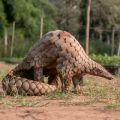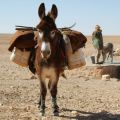
Patents can help us understand wildlife trade trends, new study shows
Researchers from the Oxford Martin Programme on Wildlife Trade at the University of Oxford have demonstrated that patent data could provide a novel source of evidence that can help identify future commercial trends associated with the overharvesting of wildlife. The findings have been published in Nature Communications.
The tools we now have to identify trends and shifts in such data are allowing us to develop crucial insights into the effects that human activity is having, and will have, on the natural world.
Professor Joss Wright, Oxford Internet Institute and Oxford Martin Programme on Wildlife Trade
If companies continue to file patents for products made from animals banned from commercial trade, such as rhinos, this can suggest a belief that these markets might reopen in the future. Patents for wildlife product alternatives, such as farmed or synthetic pangolin products, may also be indicative of a shift away from a trade in wild specimens of species.
Using a novel machine-learning approach, the research team analysed over 27,000 patents from 1970 to 2020 related to six traded organisms and found their number had increased by 130% per annum on average, compared with a background rate of 104% for patents filed globally.
They also found that stricter regulation of wildlife markets did not lead to reduced patenting.
Dr Amy Hinsley, Research Fellow and Co-Director of the Oxford Martin Programme on Wildlife Trade at the University of Oxford, and joint lead author of the paper, said:
‘Our findings show that the wildlife trade is like any other commercial trade, with businesses constantly innovating to develop new products or methods to produce them. We found a wide range of patents, from novel pangolin farming methods to new medicinal products made from rhino horn, and we were surprised to see that patenting continued, even after trade in these products was banned.’
The team looked at patenting for six different highly traded groups of organisms:
- caterpillar fungus, used in traditional medicine and food
- pangolin, whose scales and meat are consumed for traditional medicine and food, respectively
- horseshoe crab, which is used as fishing bait and whose blood is valuable in biomedicine
- sturgeon, farmed for their eggs and meat for food
- bears, whose bile is used in traditional medicine
- rhinos, whose horns are used in traditional medicine
The researchers reported that in addition to an overall increase in patent filing above the global average, patenting rates related to the study’s focal organisms surged at certain key points. For example, there was a spike in patents for medicinal rhino products over March 2008, coinciding with that year’s significant increase in poaching. This increase occurred despite China domestically banning such products since 1993.
Our novel study suggests that regulatory measures such as commercial trade bans do not mean the end of trade in particular species and their derivatives. To prevent the overexploitation of wild species necessitates understanding the complex systems in which harvest and trade take place, including different actors and their incentives, and then devising interventions that are most likely to result in sustainability
Co-author Dr Dan Challender, Research Fellow with the Oxford Martin Programme on Wildlife Trade
This means that patenting generally increased even after the introduction of regulations that banned or heavily regulated commercial trade in wildlife. In the case of rhino horn, all 526 patents were filed after a 1977 international commercial trade ban for wild products; of these, 426 were filed in China after the 1993 ban. This suggests that companies are either hoping for a relaxation of rules banning such products or planning to develop products using illegally-acquired horn.
Finally, the researchers also reported that ongoing innovation has led to a diversification of wildlife-derived products, such as rhino horn snuff products and livestock feed containing pangolin scales.
Policymakers could work with businesses and entrepreneurs identified by such patents to proactively develop measures that encourage commercial innovation as well as work towards meeting sustainability and conservation goals, say the researchers.
Professor Joss Wright, Senior Research Fellow at the Oxford Internet Institute, Co-Director of the Oxford Martin Programme on Wildlife Trade at the University of Oxford, and joint lead author of the paper, said: ‘To understand the complexities of the wildlife trade, and the risks it poses to species, we need to draw on all the data at our disposal. Our study shows that emerging computational methods can help us to find patterns in large and complex datasets across a wide range of perspectives, from species populations, to environmental measurements, to human behaviour.’
The paper’s authors are affiliated to the Department of Biology, Oxford Internet Institute, and Said Business School at the University of Oxford; as well as the Naturalis Biodiversity Centre in the Netherlands.
The study ‘Early warning of trends in commercial wildlife trade through novel machine-learning analysis of patent filing’ has been published in Nature Communications.
 New study estimates NHS England spends 3% of its primary and secondary care budget on the health impacts of temperature
New study estimates NHS England spends 3% of its primary and secondary care budget on the health impacts of temperature
 International collaboration launches largest-ever therapeutics trial for patients hospitalised with dengue
International collaboration launches largest-ever therapeutics trial for patients hospitalised with dengue
 Oxford-built multi-agent assistant for cancer care to be piloted in collaboration with Microsoft
Oxford-built multi-agent assistant for cancer care to be piloted in collaboration with Microsoft
 World's first Phase II Nipah virus vaccine trial launch
World's first Phase II Nipah virus vaccine trial launch
 More than 900 at-risk animal and plant species not covered by global trade protections, new research shows
More than 900 at-risk animal and plant species not covered by global trade protections, new research shows
 Operation Pangolin launches to save world’s most trafficked wild mammal
Operation Pangolin launches to save world’s most trafficked wild mammal
 Sale of donkey skins linked to trade in illegal wildlife products
Sale of donkey skins linked to trade in illegal wildlife products